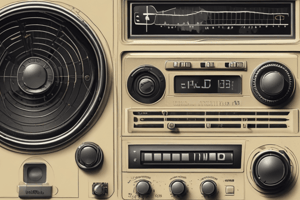Podcast
Questions and Answers
What is the recommended method for cleaning the external surfaces of portable radio equipment?
What is the recommended method for cleaning the external surfaces of portable radio equipment?
- Use solvents or spirits for cleaning.
- Submerse the radio in a detergent solution.
- Use a mild detergent solution only. (correct)
- Wipe with any type of cloth.
Which type of cleaning cloth should be used on battery contacts to ensure good electrical connections?
Which type of cleaning cloth should be used on battery contacts to ensure good electrical connections?
- Cotton cloth.
- Paper towel.
- Microfiber cloth.
- Lint-free cloth. (correct)
What channel limitations does the Visar radio have compared to other models?
What channel limitations does the Visar radio have compared to other models?
- It offers unlimited channels.
- It has fewer channels than MX800 and Astro 800 radios. (correct)
- It supports all communication protocols.
- It can only operate on emergency channels.
How often should a daily inventory of portable radios be performed?
How often should a daily inventory of portable radios be performed?
During which circumstances should units check the channels not normally used?
During which circumstances should units check the channels not normally used?
What is a crucial precaution when applying the detergent-water solution to portable radio equipment?
What is a crucial precaution when applying the detergent-water solution to portable radio equipment?
What should be recorded after checking radio channels?
What should be recorded after checking radio channels?
What type of brush is recommended for applying the detergent during cleaning?
What type of brush is recommended for applying the detergent during cleaning?
What is the correct antenna type for the MX 800 radio model?
What is the correct antenna type for the MX 800 radio model?
Which of the following is NOT a required piece of information when requesting a replacement antenna?
Which of the following is NOT a required piece of information when requesting a replacement antenna?
What is the proper protocol for identifying when initiating a radio message?
What is the proper protocol for identifying when initiating a radio message?
Which antenna type corresponds with the Visar radio model?
Which antenna type corresponds with the Visar radio model?
What is explicitly prohibited during radio conversations?
What is explicitly prohibited during radio conversations?
When making adjustments or changes to radio equipment, who is authorized to do so?
When making adjustments or changes to radio equipment, who is authorized to do so?
What should be communicated to signify that a message was received and understood?
What should be communicated to signify that a message was received and understood?
Which radio model uses a 5-1/4” Black antenna?
Which radio model uses a 5-1/4” Black antenna?
What action should be taken if water is suspected in a portable radio?
What action should be taken if water is suspected in a portable radio?
When must the portable radio batteries be changed?
When must the portable radio batteries be changed?
At what frequency should portable radios be tested?
At what frequency should portable radios be tested?
What must be done after the radio LCD indicates a 'LOW BATTERY' alert?
What must be done after the radio LCD indicates a 'LOW BATTERY' alert?
What should be the condition of a battery after one reconditioning cycle?
What should be the condition of a battery after one reconditioning cycle?
What should be done if a portable radio is used continuously for more than three hours?
What should be done if a portable radio is used continuously for more than three hours?
How often should the battery be reconditioned in the station conditioner?
How often should the battery be reconditioned in the station conditioner?
What should be monitored if the portable hand-held radio experiences reception difficulties?
What should be monitored if the portable hand-held radio experiences reception difficulties?
Flashcards are hidden until you start studying
Study Notes
Cleaning of Portable Radio Equipment
- Clean external surfaces using a 0.5% mild detergent solution: one teaspoon of dishwashing detergent mixed with one gallon of water.
- Use a stiff, non-metallic brush (e.g., toothbrush) for application while avoiding excess detergent near connectors.
- Do not submerge radios in any solution or use solvents, as they can cause permanent damage.
- Wipe dry with a soft, lint-free cloth and ensure battery contacts are clean to maintain good electrical connections.
Visar Handheld Radio
- Assigned to Division Offices and command staff for routine communications.
- Limited channel availability; not as high-performing as MX800 or Astro 800 radios.
Channel Checks
- Monthly checks on underused channels are required during low-traffic times, like drills or after fires.
- Conduct checks from mobile unit to mobile unit to maintain brevity.
- Document results on the Apparatus and Equipment Check Record, F-973.
Security of Portable Radios
- Daily inventory of all portable radios is mandatory.
- Journalize daily inventory and record which members are on radio watch.
- Personnel on radio watch must be alert to respond promptly to messages.
- Use portable handheld radios for monitoring; switch to apparatus radio if reception issues arise.
Testing of Portable Radios
- Test portable radios weekly and after extended use or significant events.
- Inspect for water damage and remove battery immediately if water is suspected.
- Change batteries daily or under these conditions:
- Continuous use over three hours.
- "LOW BATTERY" indicator displays.
- Audible chirp sounds upon power-on.
- Recharge batteries at the station; avoid overcharging and recondition monthly.
- If batteries fail to reach 80% during reconditioning, exchange them and send to Piper Tech for replacement.
Antenna Specifications
- Specific antennas for radio types:
- MX 800: 7” Black
- Astro Mutual Aide: 5-1/4” Black
- Visar: 3-1/2” Black
- To request a replacement antenna, contact FCCII with station number, radio type, radio number, and assigned unit details.
Radio Communication Protocol
- Initiate radio messages by identifying the intended receiver followed by the transmitter's designation (e.g., "Engine 2 from Metro").
- Conversations must remain professional; avoid personal greetings.
- Respond to direct questions with concise answers; use "Roger" to confirm message understanding.
Studying That Suits You
Use AI to generate personalized quizzes and flashcards to suit your learning preferences.


